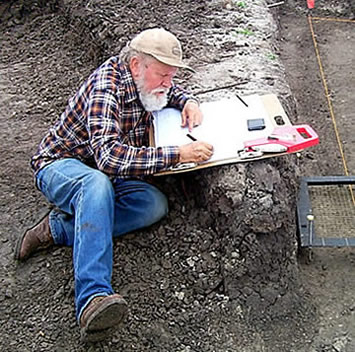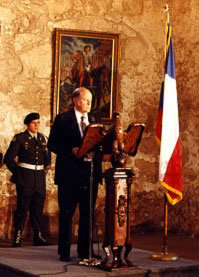
THC Executive Director Curtis Tunnell
making a presentation at the Alamo. In earlier days,
Tunnell conducted excavations at the San Antonio shrine
and other Spanish Colonial sites in Texas. Photo courtesy
THC. Click to enlarge.
|
|
Curtis was literally a man for all seasons and all
situations. He had remarkable intellectual capabilities
coupled with great sensitivity and an unrelenting love
for life. He had the uncanny ability to open new worlds
of observation, perception, and understanding for everyone
who was fortunate enough to come in contact with him--for
people of all walks of life…. Remarkably, he could
be equally at home "kicking rocks" in a farmer's
field or discussing the political climate at a black-tie
function in the Capitol building.
—Robert Mallouf
|

Archeologist Mardith Scheutz with
Tunnell during excavations at the Alamo in 1966. Photo
courtesy THC.
|
|
Curtis and (his wife) Nancy and I have joked about
him and me being inheritors and victims of the "Cowboy
Ethic." That is the ethic subscribed to by the
old gentlemen cowboys of West Texas, and imparted to
us by our cowboy ancestors….The Cowboy Ethic asks
that you be constantly humble and self-effacing, willing
to sacrifice for the welfare of others, to defend the
weak from the powerful, right from wrong. It would require
you to plunge into a raging river to rescue a swept-away
child, a drowning puppy, or maybe even a lady's parasol,
and to say when you waded ashore after completing your
mission, "Aw shucks, ma'am, 'tweren't nothin'."
—Mark Parsons
|
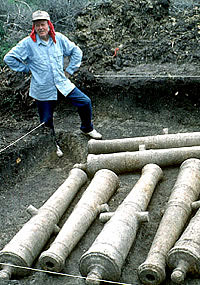
Tunnell with bronze cannons excavated
at the Fort St. Louis site by the THC in 1999. As THC
Archeology Division director Jim Bruseth noted, Tunnell
took on his retirement years with characteristic gusto:
"I recently looked back over some photographs of
Curtis at Fort St. Louis, and in every one he has a
twinkle in his eye." Photo courtesy THC.
|
|
He presented his stories like a seasoned thespian,
and they often came complete with one-liners, songs,
and even choreography. Through his memory I picked cotton
on the rolling plains, waited in the dark for the midnight
train, washed terrazzo floors in Canyon, dined with
LBJ, hugged the neck of Ann Richards, relived the night-into-day
flashes of atomic blasts, marveled at the magic of willow
furniture and paper flowers, searched for the hidden
meaning of Guatemalan textiles, and protested inequality
at an Austin lunch counter.
—Dan Utley
|
|
Curtis Dale Tunnell
Texas lost a living legend on April 13, 2001.
Longtime archeologist, preservationist, oral historian, and
folklorist Curtis Tunnell passed away in Austin at the age
of 67. A native of Turkey, in Hall County, Tunnell recalled
his homeland of the Texas rolling plains as "a beautiful
place for a boy to grow up in the years before World War II.
My earliest memories," he recalled, "were of looking
toward the west and seeing the sculptured purple silhouette
of the Caprock. This rugged escarpment of the plains beckoned
steadily, from the Quitaque Peaks on the south to Eagle's
Point on the north. This vista always made my mind take flight."
The land had a tremendous impact on Tunnell,
as did his encounters with various cultures, both ancient
and modern. By the time he left home for West Texas State
College in Canyon, his interests in geology, paleontology,
and anthropology were already developing.
At West Texas, Tunnell worked in the Panhandle-Plains
Historical Museum, one of the leading archeological research
centers in the state. There, he met his lifelong mentor, Jack
Hughes. Together, they covered vast areas of the Texas Panhandle,
conducting archeological investigations on rock shelters,
pit burials, bison kill sites, and countless other projects.
While in college, Tunnell participated in military
training through Officers Candidate School. Upon graduation
he joined the U.S. Navy and saw service in the Pacific, ferrying
supplies to such outposts as Johnston Island, the Midway Islands,
and the Marshalls. His ship, the USS Kishwaukee, was also
involved in early atomic bomb testing at the Bikini and Enewetak
atolls.
Following military service, Tunnell returned
to Texas and began working with archeologist Ed Jelks on the
Texas River Basins Survey project funded by the Smithsonian
Institution. Their first investigations took place along the
McGee Bend of the Angelina River in East Texas, later impounded
as part of Sam Rayburn Reservoir. He also worked in the Lake
Amistad area along the Rio Grande. Tunnell followed his fieldwork
with graduate studies at The University of Texas at Austin,
receiving a master's degree in anthropology.
From there, he became a field researcher for
the University of Illinois and worked on such sites as the
famed Cahokia Mounds, as well as projects in Kansas and Arizona.
He then returned to Austin as Curator of Anthropology for
the Texas Memorial Museum. There, he and W. W. Newcomb undertook
pioneering work at a site that proved to be the location of
Mission San Lorenzo de la Santa Cruz, established by the Spanish
in 1762 to minister to the Lipan Apache.
In 1965, public demand for historic and archeological
preservation led the Texas Legislature to create the position
of State Archeologist. For the first time, Texas had a formal
public archeology program, and the person selected to fill
the new position was Curtis Tunnell. First assigned to the
Texas State Building Commission, the State Archeologist was
transferred to the Texas State Historical Survey Committee
(later the Texas Historical Commission) in 1969.
As State Archeologist, Tunnell participated
in scientific investigations at the Alamo and other important
Spanish Colonial mission and presidio sites in Texas, directed
archeological excavations at the ancient Folsom-age Adair-Steadman
site, and braved the waters of the Rio Grande in order to
record the archeological resources present in the canyons
of the Big Bend region.
He battled commercial salvagers to retain the
1554 Spanish shipwreck artifacts for the State of Texas and
was instrumental in the development of the Antiquities Code
of Texas, the legal tool to protect historic resources on
public (state) land, including submerged shipwrecks. His films
and audiotapes documenting the work of numerous folk artisans
and craftsmen in the Texas-Mexico border region may well represent
the only records of the practitioners of many vanishing crafts
and arts.
In 1981, Tunnell became THC executive director,
a position he held until his retirement in January 1999. Under
his direction, the agency's traditional areas of concentration,
including the Official Texas Historical Markers, National
Register of Historic Places, Texas courthouse law, and other
preservation programs, continued to grow and expand, and new
initiatives were developed. Of special note was the initiation
of the THC's heritage tourism efforts, which were first widely
recognized through the Los Caminos del Rio Heritage Project.
Also during his tenure, the THC's Main Street
program, guided by Anice Read, gained national recognition,
and, with the support of the Texas Legislature, the Texas
Preservation Trust Fund was developed, allowing the THC to
provide matching-grant funding for significant preservation
efforts. Through his decades of state service, Tunnell traveled
to all 254 Texas counties and developed lasting friendships
in all regions of the state.
He is remembered particularly as a respected
scientist, a friend to local preservationists, a tireless
worker for "the people's history," an avid fan of
Texas music, a promoter of Texas cultural crafts, an oral
historian of Texas archeology, and a man who genuinely loved
the myriad people from all walks of life with whom he came
in contact. And that love was returned many times over. People
in each Texas county, in other states, and in remote areas
of Northern Mexico mourn his passing.
{For the complete presentation of tributes
to Curtis Tunnell as well as other information on his life,
see the THC
Curtis Tunnell Memorial.}
|
|
Curtis was a tireless time traveler on a bedrock
braided trail, more at home, perhaps, among the ancients
than the moderns with whom his lot was cast. He was
a gentle man who marveled at nature and reveled in the
stories of the past.
—Dan Utley
|
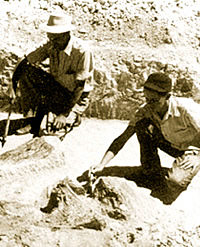
In the beginning. Jack Hughes (left)
and a "skinny kid from Turkey Texas" (right)
in the summer of 1952, excavating fossils in the Canadian
River region. The description of the skinny kid is from
Curtis' own caption for this photo. Courtesy THC. Click
to see full image.
|
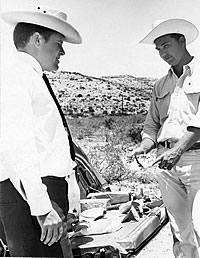
A young Curtis Tunnell and colleague
have a "tail-gate conference" in the field. Photo courtesy
THC.
|
|
In his legendary storytelling Curtis could bring
West Texas to life like no other individual. He could
make you feel the grit in your teeth with his description
of a Panhandle dust storm, and make you shiver with
cold at the prospect of a good norther. He could prop
his feet up, pick up a guitar, and sing old cowboy and
Mexican tunes that would rend your heart asunder, and
then immediately launch into an intellectual treatise
on some aspect of current scientific or political affairs.
—Robert Mallouf
|

Tunnell excavating a trader's box
full of beads, mirrors, wooden combs, brass straight
pins and other items in the aft cargo hold of La Belle.
The discovery of the shipwreck was a particularly sweet
success for Tunnell and the THC. As he told the film
crew of Nova in 1999: "I've spent the last 20 years
of my career looking for this shipwreck. I was starting
to wonder if I was ever going to find this old La Salle
ship in my lifetime."
|
|
Few at the Historical Commission ever fretted about
working "for" Curtis. Most of the time, we
all worked "with" him, a management technique
he felt most comfortable with, and under which we all
accomplished much. So much.
—Jim Steely
|
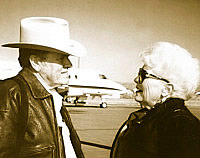
Tunnell with Governor Ann Richards.
Photo courtesy THC.
|
|
We will not see his likes again, and that makes
me sad, not just for myself and his countless other
friends, but for those generations that follow without
the guiding glow that was his life. So, we still have
work to do in his memory. His legacy deserves no less.
—Dan Utley
|

Tunnell measures the depth of a cistern,
with Dan Scurlock, right, providing shade with a straw
hat, at Fort Phantom Hill near Abilene in 1971. Click
to see full image.
|
|




